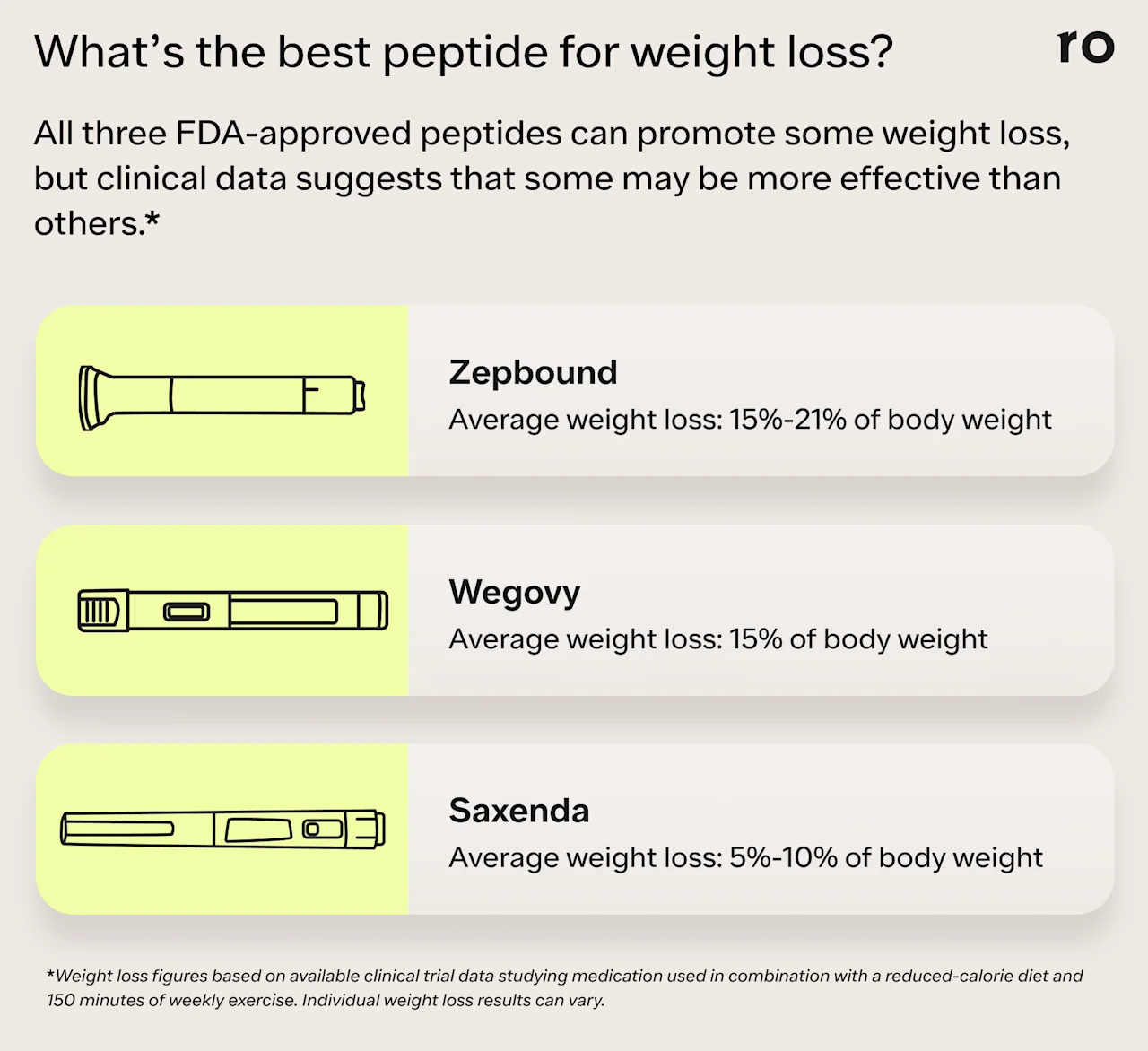Key takeaways
Peptides are short chains of amino acids. Some well-known peptides for weight loss include GLP-1 medications, such as Wegovy, Zepbound, and Saxenda.
These medications mimic naturally occurring peptide hormones in the body that impact hunger, digestion, and blood sugar management.
Peptides can help support weight loss, but they often work best when paired with healthy lifestyle changes.
Here's what we'll cover
Here's what we'll cover
Here's what we'll cover
Key takeaways
Peptides are short chains of amino acids. Some well-known peptides for weight loss include GLP-1 medications, such as Wegovy, Zepbound, and Saxenda.
These medications mimic naturally occurring peptide hormones in the body that impact hunger, digestion, and blood sugar management.
Peptides can help support weight loss, but they often work best when paired with healthy lifestyle changes.
If you’ve been researching weight loss tools online, you may have come across discussions about peptides for weight loss.
Peptides are short chains of two or more amino acids, which are the building blocks of proteins—and they’re also the key ingredient in some of the buzziest new medications for type 2 diabetes and obesity.
While some synthetic (manmade) peptides may be marketed for muscle building and weight loss, only certain ones are specifically approved by the US Food and Drug Administration (FDA) for weight loss. This includes prescription glucagon-like peptide-1 (GLP-1) receptor agonist medications, available under the brand names Wegovy, Zepbound, and Saxenda. These peptides work by mimicking the hormone GLP-1 and may promote significant weight loss when used in tandem with sustainable lifestyle changes to diet, exercise, and more.
Read on to learn more about peptide therapy for weight loss, including how it works, which peptides are more effective, side effects, safety, and more.
Hear from Ro patients
Ro members taking branded GLP-1 medications were paid for their testimonials.
How peptides work for weight loss
Our bodies naturally produce peptides, and some are considered peptide hormones. Certain peptide hormones may play a role in weight management due to their effects on appetite, blood sugar control, and how we convert food or stored energy into usable energy.
Peptide hormones that may impact weight include:
Insulin. Produced in the pancreas, insulin helps move glucose (sugar) into cells to be used for energy.
Ghrelin. Produced primarily in the stomach and some other parts of the body (e.g., small intestine, pancreas, and brain), ghrelin tells your brain you’re hungry.
Leptin. Produced in fat cells, leptin tells the brain you’re full or satisfied while and after eating.
GLP-1. Produced in the small intestine, GLP-1 increases insulin secretion, suppresses glucagon production, reduces appetite, and slows digestion.
GIP. Also produced in the intestines, glucose-dependent insulinotropic polypeptide (GIP) works alongside GLP-1 to help keep appetite in check, stimulate insulin secretion, and help control blood sugar. (A polypeptide is a longer, unbranched peptide chain.)
How well these peptide hormones function in the body may influence weight. For example, insulin resistance (when cells are less sensitive to insulin signaling) can lead to weight gain. Conversely, weight gain can cause insulin resistance.
With obesity, the body can also become leptin resistant. This occurs when fat tissue overproduces leptin and the brain doesn’t respond to leptin’s signals around fullness and satiety.
Ghrelin levels may also be different in people with obesity. After you eat, levels of ghrelin, also called the “hunger hormone,” decrease. However, researchers have found that post-meal ghrelin levels in people with obesity are higher than in people without. So, even after eating a satisfying meal or snack, you may continue to eat or experience the quick return of cravings.
People who have obesity or overweight may also experience reduced GLP-1 secretion. Some studies suggest that in people with obesity (where GLP-1 secretion is reduced), GIP may be elevated and may promote fat storage, but more research is needed regarding GIP secretion and obesity.
Since naturally occurring peptides may be altered with obesity and overweight, the use of synthetic peptides—such as GLP-1 receptor agonists—may help.
These weight loss injections work to promote weight loss by doing the following:
Increasing satiety. These peptides can help slow gastric emptying, or the rate at which food moves from your stomach to the small intestine. This may make you feel full earlier and help you feel satisfied for longer after meals or snacks.
Decreasing hunger cues. GLP-1s and dual GLP-1/GIPs can activate GLP-1 receptors in your brain, helping to suppress appetite and quiet “food noise,” a nonmedical term that describes a type of intrusive preoccupation with food.
Improving insulin sensitivity. People with obesity may also have insulin resistance, which can cause blood sugar levels to remain high and excess sugar to be stored as fat. GLP-1 can help your pancreas produce more insulin. The increased insulin production can help lower blood sugar levels and reduce insulin resistance. Enhancing insulin sensitivity may also promote weight loss.
What are the best peptides for weight loss?
There are currently three FDA-approved GLP-1 and dual GLP-1/GIP medications for weight loss.

Wegovy
Wegovy (semaglutide)is a GLP-1 receptor agonist. It’s FDA-approved for weight management in adults and children aged 12 and older with obesity or for adults with overweight who also have at least one weight-related health condition, such as type 2 diabetes, dyslipidemia, or high blood pressure. Wegovy is also approved to help reduce the risk for major cardiovascular events (such as heart attack and stroke) in people with overweight or obesity who also have heart disease.
Wegovy comes in a single-use pen that you inject once each week on the same day each week. It comes in five dose strengths: 0.25 mg, 0.5 mg, 1 mg, 1.7 mg, and 2.4 mg.
Saxenda
Saxenda(liraglutide)is also a GLP-1 medication. Like Wegovy, it’s approved for weight management in adults and children aged 12 and up who live with obesity and for adults with overweight and a related condition, such as hypertension, type 2 diabetes, or high cholesterol.
Unlike some other GLP-1s, Saxenda is a daily medication—it comes in a multi-dose pen that you inject once per day. Saxenda comes in 0.6 mg, 1.2 mg, 1.8 mg, 2.4 mg, and 3 mg doses.
Zepbound
Zepbound (tirzepatide) is a dual-action GLP-1/GIP receptor agonist that mimics both GLP-1 and GIP hormones. It’s approved for weight loss in adults with obesity and overweight and one comorbid health condition. It’s also approved to treat obstructive sleep apnea (OSA) in adults with obesity and OSA.
Zepound is a weekly injection that comes in single-dose pens or single-use vials that you inject with a syringe. Zepbound has six dose strengths: 2.5 mg, 5 mg, 7.5 mg, 10 mg, 12.5 mg, and 15 mg.
Other GLP-1s and GLP-1/GIP medications are approved for the treatment of type 2 diabetes rather than weight loss, but healthcare providers may sometimes prescribe these off-label to treat obesity or overweight. GLP-1 medications include Ozempic (semaglutide), Victoza (liraglutide), and others, while GLP-1/GIP medications include Mounjaro (tirzepatide).
How much weight can you lose with peptide therapy?
Research suggests that semaglutide, liraglutide, and tirzepatide can all be effective tools for weight loss. They may help people lose 5%--20% or more of their body weight when combined with diet and exercise changes. Semaglutide and tirzepatide are more likely to produce these specific results when compared to liraglutide.
That said, how much weight you can lose with these medications depends on factors like your starting weight, lifestyle changes, underlying health conditions, the specific medication you’re taking, your dosage, and more.
Let’s take a closer look at what the research says about the weight loss potential for each medication.
Semaglutide (Wegovy, Ozempic)
In a Phase 3 clinical trial, people with type 2 diabetes (who hadn’t previously received treatment aside from lifestyle changes) received either 0.5 mg or 1 mg of semaglutide or a dose-matched placebo as a once-weekly injection for 30 weeks (about 7.5 months). Participants taking 0.5 mg of semaglutide lost about 8 pounds on average. Those taking 1 mg lost an average of 10 pounds.
In another Phase 3 clinical trial, participants with obesity or overweight who took a once-weekly injection of 2.4 mg of semaglutide (the maximum dose of Wegovy) and who adhered to a reduced-calorie diet and regular exercise lost an average of 15% of their weight over the 68-week (or 1.3-year) study.
Long-term studies also show promising weight loss outcomes. Research shows that 2.4 mg of semaglutide is associated with, on average, a 10% reduction in weight over about four years.
Liraglutide (Saxenda, Victoza)
A 2016 research review analyzing five liraglutide clinical trials found that the medication, along with diet and lifestyle changes, produced a weight loss of 5%-10% in most participants. People with prediabetes who completed a 56-week clinical trial and received 3 mg of liraglutide (the maximum dose of Saxenda) lost an average of 8% of their body weight in conjunction with lifestyle changes.
Tirzepatide (Zepbound, Mounjaro)
While similar to other GLP-1 medications, tirzepatide works in a slightly different way because it acts on receptors for both GLP-1 and GIP hormones. Clinical trial data suggests that this dual-action mechanism may make it more effective for weight loss, though more research is needed to confirm this.
In a 2021 trial comparing tirzepatide (at various doses) and semaglutide (at 1 mg), the participants receiving tirzepatide had greater reductions in body weight than those on semaglutide. Those receiving 1 mg of semaglutide saw an average reduction of 5.7 kg (about 12.5 pounds) of body weight. Those receiving 5 mg, 10mg, and 15 mg doses of tirzepatide experienced an average reduction of 7.6 kg (about 17 pounds), 9.3 kg (about 20 pounds), and 11.2 kg (about 25 pounds), respectively.
A 2024 cohort study analyzed electronic health records for 18,386 people who were taking either semaglutide or tirzepatide between May 2022 and September 2023. Researchers found that people receiving tirzepatide lost about 7% more weight than those receiving semaglutide injections in the first year on the medication. However, both medications produced at least a 5% decrease in body weight for most of the cohort.

Lifestyle tips to maximize peptide therapy results
GLP-1s and GLP-1/GIPs work best when combined with sustainable lifestyle changes, such as:
A balanced, nutritious diet
Regular exercise (about 150 minutes per week)
Getting adequate sleep
Managing stress
Staying hydrated (be it with plain still or sparkling water)
Think of these peptides as just one tool in your arsenal for achieving your weight loss goals, with each lifestyle change being another tool.
These medications are also designed as long-term treatments, not quick fixes—some people may take them indefinitely to maintain weight loss results. Once you stop taking GLP-1 medications, you may experience a spike in hunger levels and regain some or most of the weight you lost. Healthy lifestyle interventions like a balanced diet and exercise may help mitigate weight gain.
Are peptides safe?
Peptides that are FDA-approved for weight loss—such as Wegovy, Zepbound, and Saxenda—have gone through extensive testing for safety and efficacy. They are generally considered safe when used as directed by your prescribing healthcare provider.
Keep in mind that some retailers may sell “knockoff” versions of these medications or may market non-prescription peptide formulations that claim to promote weight loss. The FDA hasn’t vetted or approved these products, and they may come with health risks.
If you’re interested in peptide therapy, talk to a knowledgeable healthcare provider about getting a prescription for weight loss medication. They can evaluate your health history and goals to determine if peptide therapy is appropriate for you.
Side effects of weight loss peptides
While GLP-1s and GLP-1/GIP medications are generally well tolerated, they may cause mild but manageable gastrointestinal (GI) side effects.
Common side effects tend to appear when you first start taking the medication or when your healthcare provider moves you to a higher dose strength. However, side effects typically go away as your body adjusts to the medication.
Common side effects can vary depending on which medication you’re taking but may include:
Vomiting
Abdominal pain
Diarrhea
Dyspepsia (indigestion)
To help mitigate the risk of side effects, your healthcare provider will likely start you on a low dose while your body gets acquainted with the medication before slowly increasing your dose to your maintenance level.
They may also recommend tips like eating smaller meals, avoiding certain foods and drinks, or taking anti-nausea medication to help with mild GI side effects.
Serious side effects may also occur with GLP-1 medications, though these are rare.
Rare but serious side effects may include:
Allergic reactions. Symptoms may include facial or throat swelling, difficulty breathing or swallowing, itching or rash, fainting or feeling dizzy, or rapid heartbeat.
Inflammation of the pancreas (pancreatitis). Symptoms may include severe abdominal pain that doesn’t go away and sometimes back pain.
Gallbladder problems. Symptoms may include pain in the upper abdomen, fever, yellowing of the skin or eyes, or clay-colored stools.
Kidney problems (kidney failure). People with existing kidney problems may notice worsening symptoms if they become chronically dehydrated.
Low blood sugar (hypoglycemia) in people with type 2 diabetes. Symptoms may include dizziness or lightheadedness, blurred vision, mood changes, sweating, slurred speech, hunger, confusion, drowsiness, shakiness, weakness, headache, rapid heartbeat, or feeling jittery.
Vision changes. Symptoms may include blurred vision, floaters, or spots. For people with type 2 diabetes who also have a history of diabetic retinopathy (a condition that can cause blood vessel damage in the retina), these medications may worsen symptoms. People with a known history of diabetic retinopathy should be closely monitored while taking these medications.
Gastroparesis or bowel obstruction. Some research has found that these meds may be associated with gastroparesis (stomach paralysis) and bowel obstruction. Symptoms can include bloating, abdominal pain, and vomiting.
Most GLP-1s and GLP-1/GIPs contain a black box warning about the potential increased risk for certain thyroid tumors. While this type of cancer was only found in rodent studies (not in humans), people who have a personal or family history of thyroid cancer, including medullary thyroid carcinoma (MTC) or MEN2 syndrome, shouldn’t take GLP-1s or GLP1/GIPs.
Due to an increased risk for certain side effects, these medications may not be suitable for everyone. This may include:
People who are pregnant, breastfeeding, or planning to become pregnant
People with a personal or family history of pancreatitis or kidney issues
People with a personal or family history of thyroid tumors
People with a known allergy to any ingredients in the medication
Your healthcare provider should carefully assess whether you are a candidate for taking a peptide for weight loss based on factors like your personal and family health history, weight and health goals, any underlying health conditions, and more.
Common myths and misconceptions about peptides
Myth: Peptides are steroids
Fact: While certain synthetic peptides may help promote muscle growth, they are not anabolic steroids that people use to build muscle. Peptides are also not corticosteroids, which are used for numerous health reasons to combat inflammation and suppress the immune system.
Myth: Peptides work instantly
Fact: Peptides for weight loss start working right away, but it can take time to produce results. Rather than taking a peptide for a few months, you may need to take it long-term or at least for a year to see the results reflected in clinical trials. People taking weight loss peptides also need to incorporate lifestyle changes, not only for best results but also to help prevent weight regain if stopping the medication.
Myth: All peptides are the same
The GLP-1s on the market all mimic the body’s natural GLP-1 hormone, but not all peptides work the same. Other natural and synthetic peptides perform different functions in the body and have different purposes and mechanisms. For example, collagen peptides may be helpful for anti-aging, bone density, muscle strength, and skin health.
Questions to ask your HCP about peptides for weight loss
If you’re interested in GLP-1s for weight loss, talk to your healthcare provider. They can help determine if one of these drugs is appropriate for you or if an alternative medication might better suit your health goals.
Here are a few questions you may want to ask your healthcare provider about peptides for weight loss:
Am I a candidate for weight loss treatment with peptides?
Which peptide for weight loss is best for my health history and goals?
What lifestyle changes should I make in conjunction with taking a peptide for weight loss?
What should I do if I experience side effects?
What can I expect long term?
How much weight can I lose?
How much do weight loss drugs cost?
Will my insurance cover my medication?
Are there other alternatives I should try first?
Bottom line
When used under the guidance of a knowledgeable healthcare provider, peptide therapy can be an effective tool for weight loss.
Peptides for weight loss include GLP-1 receptor agonist medications such as Wegovy and Saxenda, as well as dual GIP/GLP-1 receptor agonists like Zepbound.
These medications work by mimicking naturally occurring peptide hormones in the body that impact hunger, digestion, and blood sugar management. The combined effect of these actions can help promote weight loss.
Synthetic peptide injections can help kickstart weight loss, but they work best when used in conjunction with a balanced diet and regular exercise.
Weight-loss peptides may cause GI side effects like nausea, vomiting, diarrhea, and constipation. These common side effects are typically mild and manageable and tend to go away as your body adjusts to the medication.
Peptides for weight loss like Wegovy, Saxenda, and Zepbound are all FDA-approved medications that require a prescription from a licensed healthcare provider. Be wary of “knockoff” or non-prescription versions of these drugs that have not been thoroughly tested for safety or efficacy.
Frequently asked questions (FAQs)
Do peptides for weight loss really work?
Yes, FDA-approved peptides for weight loss like Zepbound, Wegovy, and Saxenda can work. However, your weight loss results may differ from someone else taking the same drug because several factors play a role in how much weight a person loses, including their starting weight, underlying conditions, dosage, lifestyle changes, and more.
What is the best peptide to take for weight loss?
Research suggests that Zepbound (tirzepatide) may promote more weight loss than other similar drugs, but weight loss results alone may not be the only factor to consider when choosing a medication. Your healthcare provider can help find the best weight-loss peptide for you based on your weight loss goals, health history, cost and insurance considerations, and more.
What are the negatives of peptides?
As with any medication, weight loss peptides like Wegovy, Saxenda, and Zepbound may have potential side effects. Your healthcare provider can work with you to help minimize any potential side effects, which often go away as your body gets used to the medication.
Another potential drawback is that most people will need to take these medications for a long time—in some cases, indefinitely—to see sustained weight loss results.
Do you need a prescription for peptides for weight loss?
Yes, you need a prescription to take a peptide for weight loss, such as Wegovy, Saxenda, Zepbound, and others.
DISCLAIMER
If you have any medical questions or concerns, please talk to your healthcare provider. The articles on Health Guide are underpinned by peer-reviewed research and information drawn from medical societies and governmental agencies. However, they are not a substitute for professional medical advice, diagnosis, or treatment.
GLP-1 Important Safety Information: Read more about serious warnings and safety info.
Wegovy Important Safety Information: Read more about serious warnings and safety info.
Zepbound Important Safety Information: Read more about serious warnings and safety info.
Saxenda Important Safety Information: Read more about serious warnings and safety info.
Ozempic Important Safety Information: Read more about serious warnings and safety info.
Mounjaro Important Safety Information: Read more about serious warnings and safety info.
References
Alkhezi, O. S., Alahmed, A. A., Alfayez, O. M., et al. (2023). Comparative effectiveness of glucagon-like peptide-1 receptor agonists for the management of obesity in adults without diabetes: A network meta-analysis of randomized clinical trials. Obesity Reviews : An Official Journal of the International Association for the Study of Obesity, 24(3), e13543. doi: 10.1111/obr.13543. Retrieved from https://pubmed.ncbi.nlm.nih.gov/36579723/
Baggio, L. L. & Drucker, D. J. (2014). Glucagon-like peptide-1 receptors in the brain: controlling food intake and body weight. The Journal of Clinical Investigation, 124(10), 4223. doi: 10.1172/JCI78371. Retrieved from https://pmc.ncbi.nlm.nih.gov/articles/PMC4191040/
Chia, C. W. & Egan, J. M. (2019). Incretins in obesity and diabetes. Annals of the New York Academy of Sciences, 1461(1), 104. doi: 10.1111/nyas.14211 Retrieved from https://pmc.ncbi.nlm.nih.gov/articles/PMC10131087/
Collins, L. & Costello, R. A. (2024). Glucagon-Like Peptide-1 Receptor Agonists. StatPearls. Retrieved from https://www.ncbi.nlm.nih.gov/books/NBK551568/
Dash, S. (2024). Opportunities to optimize lifestyle interventions in combination with glucagon-like peptide-1-based therapy. Diabetes, Obesity, and Metabolism, 26(4),3-15. doi: 10.1111/dom.15829. Retrieved from https://pubmed.ncbi.nlm.nih.gov/39157881/
Forbes, J. & Krishnamurthy, K. (2023). Biochemistry, peptide. StatPearls. Retrieved from https://www.ncbi.nlm.nih.gov/books/NBK562260/
Frías, J. P., Davies, M. J., Rosenstock, J., et al. (2021). Tirzepatide versus semaglutide once weekly in patients with type 2 diabetes. New England Journal of Medicine, 385(6), 503-515. doi: 10.1056/NEJMoa2107519. Retrieved from https://www.nejm.org/doi/full/10.1056/NEJMoa2107519
Gołacki, J., Matuszek, M., & Matyjaszek-Matuszek, B. (2022). Link between insulin resistance and obesity-from diagnosis to treatment. Diagnostics (Basel), 12(7),1681. doi: 10.3390/diagnostics12071681. Retrieved from https://pubmed.ncbi.nlm.nih.gov/35885586/
Harris, E. (2024). EHR data suggest tirzepatide outdoes semaglutide for weight loss. JAMA, 332(8), 610. doi: 10.1001/jama.2024.13770. Retrieved from https://jamanetwork.com/journals/jama/article-abstract/2822005
Hayashi, D., Edwards, C., Emond, J. A., et al. (2023). What is food noise? A conceptual model of food cue reactivity. Nutrients, 15(22), 4809. doi: 10.3390/nu15224809. Retrieved from https://pmc.ncbi.nlm.nih.gov/articles/PMC10674813/
Jensterle, M., Ferjan, S., Ležaič, L., et al. (2023). Semaglutide delays 4-hour gastric emptying in women with polycystic ovary syndrome and obesity. Diabetes, Obesity, and Metabolism, 25(4), 975-984. doi: 10.1111/dom.14944. Retrieved from https://pubmed.ncbi.nlm.nih.gov/36511825/
Jiahao, L., Jiajin, L., & Yifan, L. (2021). Effects of resistance training on insulin sensitivity in the elderly: A meta-analysis of randomized controlled trials. Journal of Exercise Science and Fitness, 19(4),241. doi: 10.1016/j.jesf.2021.08.002. Retrieved from https://pmc.ncbi.nlm.nih.gov/articles/PMC8429971/
Makris, C. M., Alexandrou, A., Papatsoutsos, G. E., et al. (2017). Ghrelin and obesity: identifying gaps and dispelling myths. A reappraisal. In Vivo, 31(6),047. doi: 10.21873/invivo.11168. Retrieved from https://pmc.ncbi.nlm.nih.gov/articles/PMC5756630/
Mehta, A., Marso, S. P., & Neeland, I. J. (2016). Liraglutide for weight management: a critical review of the evidence. Obesity Science & Practice, 3(1),3-14. doi: 10.1002/osp4.84. Retrieved from https://pubmed.ncbi.nlm.nih.gov/28392927/
Müller, T. D., Finan, B., Bloom, S. R., et al. (2019). Glucagon-like peptide 1 (GLP-1). Molecular Metabolism, 30, 72-130. doi: 10.1016/j.molmet.2019.09.010. Retrieved from https://pubmed.ncbi.nlm.nih.gov/31767182/
Pham, N. H. T., Joglekar, M. V., Wong, W. K. M., et al. (2023). Short-chain fatty acids and insulin sensitivity: a systematic review and meta-analysis. Nutrition Reviews, 82(2),193-209. doi: 10.1093/nutrit/nuad042. Retrieved from https://pmc.ncbi.nlm.nih.gov/articles/PMC10777678/
Rodriguez, P. J., Goodwin Cartwright, B. M., Gratzl, S., et al. (2024) Semaglutide vs tirzepatide for weight loss in adults with overweight or obesity. JAMA Internal Medicine, 184(9), 1056. doi: 10.1001/jamainternmed.2024.2525. Retrieved from https://pubmed.ncbi.nlm.nih.gov/38976257/
Ryan, D. H., Lingvay, I., Deanfield, J., et al. (2024). Long-term weight loss effects of semaglutide in obesity without diabetes in the SELECT trial. Nature Medicine, 30(7), 2049-2057. doi: 10.1038/s41591-024-02996-7. Retrieved from https://www.nature.com/articles/s41591-024-02996-7
Sobh, M. , Montroy, J. , Daham, Z., et al. (2022). Tolerability and SCFA production after resistant starch supplementation in humans: a systematic review of randomized controlled studies. American Journal of Clinical Nutrition, 115(3), 608-618. doi: 10.1093/ajcn/nqab402. Retrieved from https://pubmed.ncbi.nlm.nih.gov/34871343/
Sodhi, M., Rezaeianzadeh, R., Kezouh, A., et al. (2023). Risk of gastrointestinal adverse events associated with glucagon-like peptide-1 receptor agonists for weight loss. JAMA, 330(18), 1795. doi: 10.1001/jama.2023.19574. Retrieved from https://pmc.ncbi.nlm.nih.gov/articles/PMC10557026/
Sorli, C., Harashima, S. I., Tsoukas, G. M., et al. (2017). Efficacy and safety of once-weekly semaglutide monotherapy versus placebo in patients with type 2 diabetes (SUSTAIN 1): a double-blind, randomised, placebo-controlled, parallel-group, multinational, multicentre phase 3a trial. The Lancet Diabetes & Endocrinology, 5(4),251-260. doi: 10.1016/S2213-8587(17)30013-X. Retrieved from https://www.sciencedirect.com/science/article/abs/pii/S221385871730013X
Wilding, J. P. H., Batterham, R. L., Calanna, S., et al. (2021). Once-weekly semaglutide in adults with overweight or obesity. New England Journal of Medicine, 384(11), 989-1002. doi: 10.1056/NEJMoa2032183. Retrieved from https://www.nejm.org/doi/full/10.1056/NEJMoa2032183













